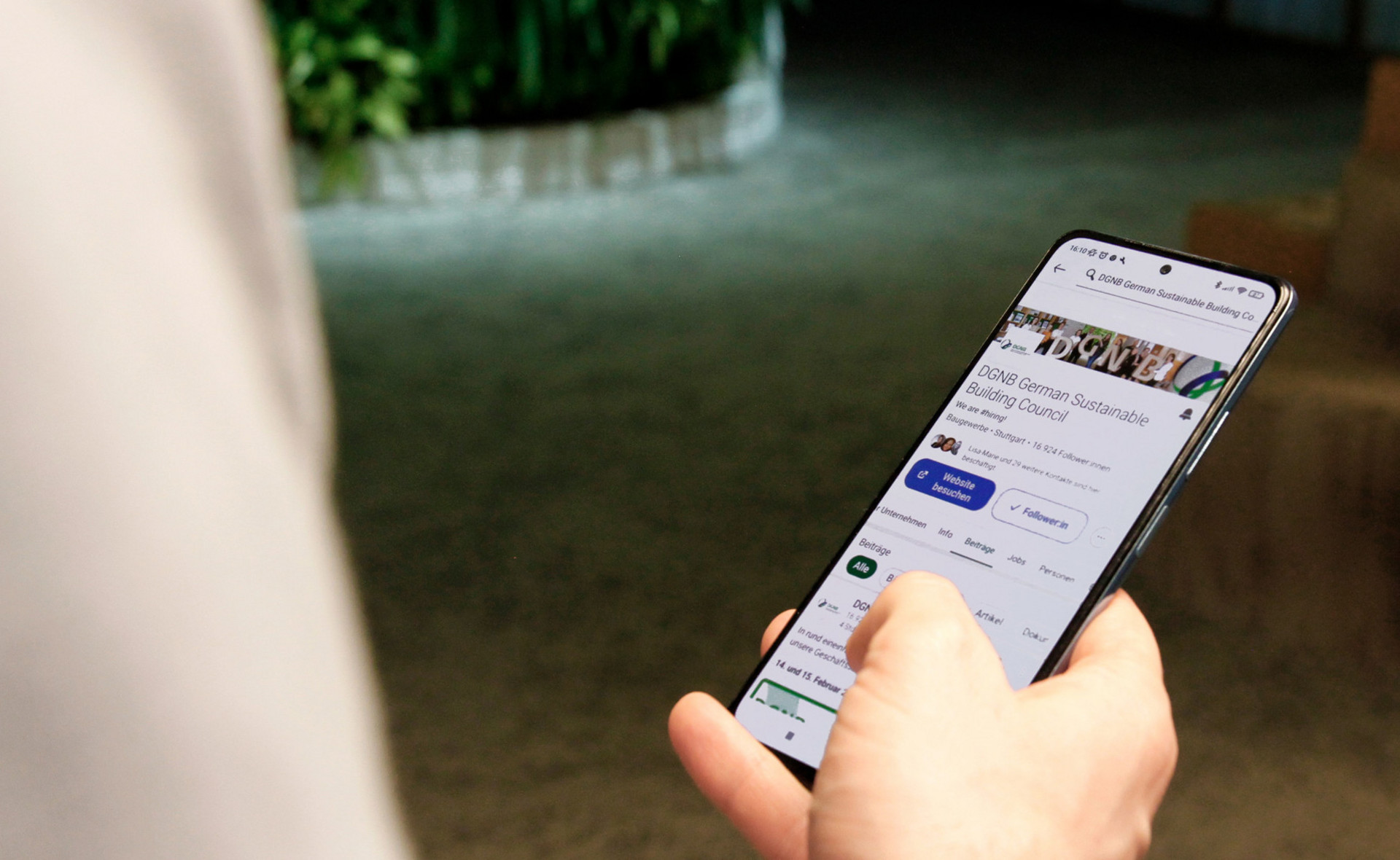What is the DGNB's position on important political decisions, energy industry developments or building specifications? Through our position papers and statements, we take a stand, provide impetus and trigger initiatives.
Position papers and statements for download
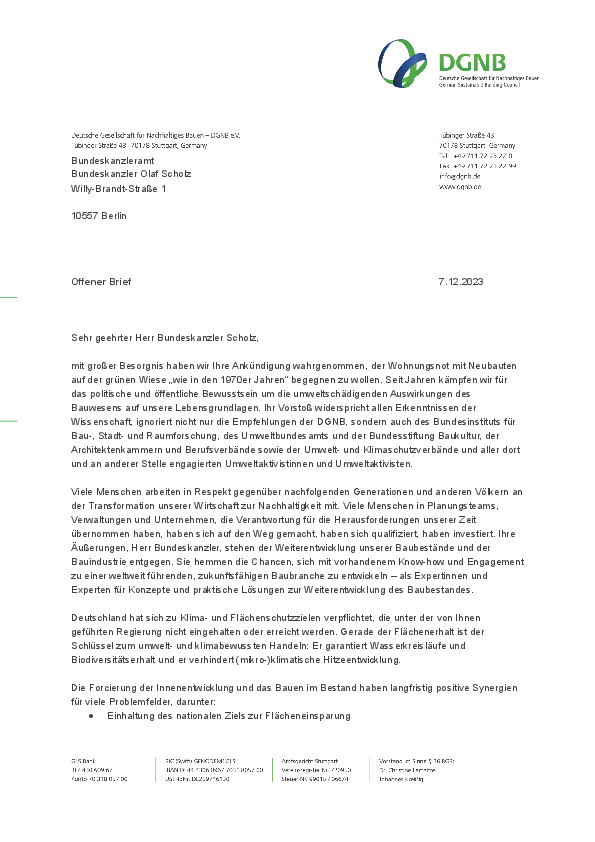
Open letter to Chancellor Olaf Scholz
In November 2023, Chancellor Olaf Scholz called for a rethink on building. Specifically: the construction of 20 new city districts as in the 1970s. The DGNB received this announcement with concern. In addition, on 30 November 2023, a court ruling classified the German government's climate protection policy as partially unlawful. On the initiative of Prof. Annette Hillebrandt of the University of Wuppertal, the DGNB, together with numerous high-ranking institutions and scientists, has therefore written an open letter to the Chancellor. In this letter, the co-signatories urgently appeal to the Chancellor to reconsider his statements and, among other things, to speak out in favour of land conservation and building in existing buildings.
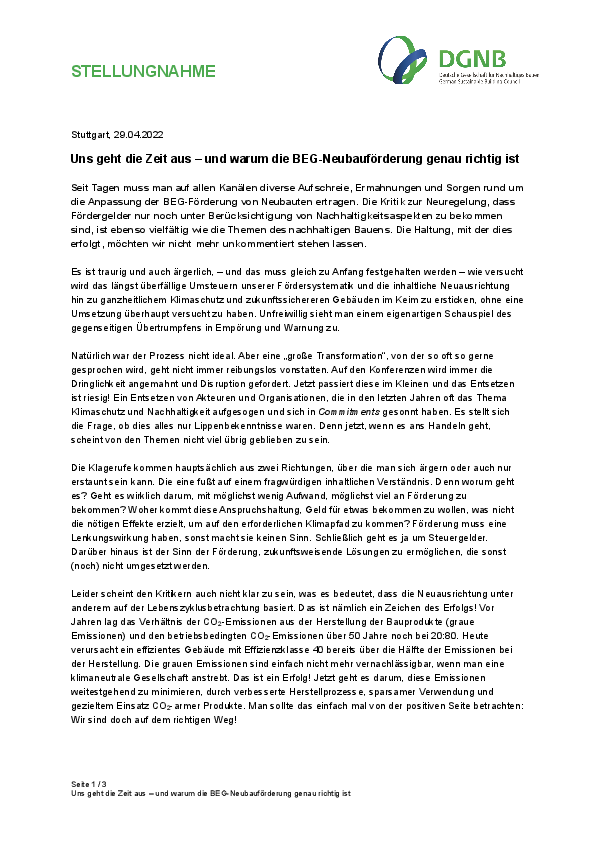
April, 2022 | We're running out of time - that's why the new Federal Funding for Efficient Buildings is just in time
For days, we have had to endure various concerns on all channels about the regulation of Federal Funding for Efficient Buildings. Criticism of the new regulation, which only allows funding if sustainability aspects are taken into account, is as varied as sustainable building issues. However, we will no longer remain silent.
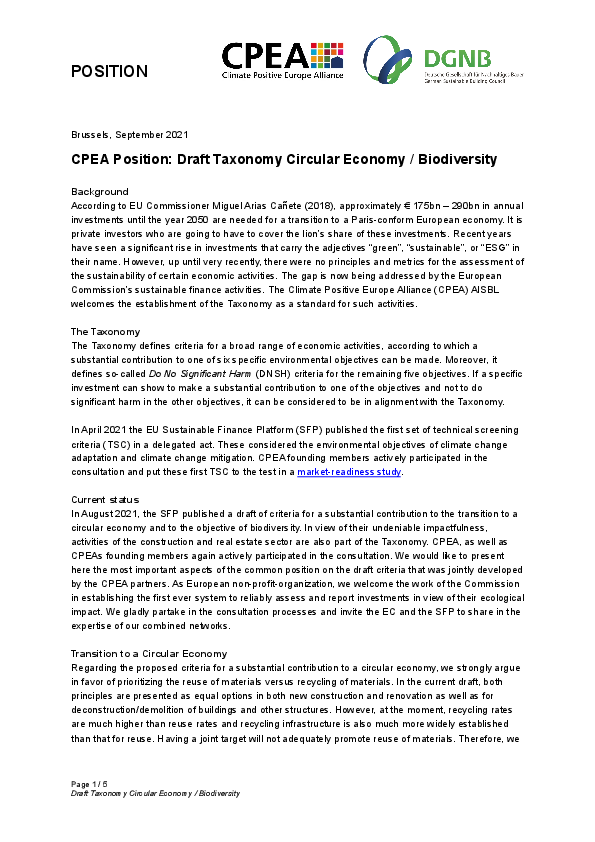
September, 2021 | CPEA Position: Drafts of a Circular Economy / Biodiversity Taxonomy
The European Sustainable Finance Platform has published the first draft of the requirements for environmental targets for the circular economy and biodiversity as part of the EU Taxonomy. Together with its partners from the Climate Positive Europe Alliance (CPEA), the DGNB participated in the consultancy and published a joint position. For the environmental goal "circular economy", it is recommended that the economic activities "new construction" and "deconstruction" should not be considered separately. Furthermore, the terms "reuse" and "recycle" should be defined more clearly. The requirements of the environmental goal "biodiversity" are not ambitious enough in the opinion of the DGNB and CPEA..
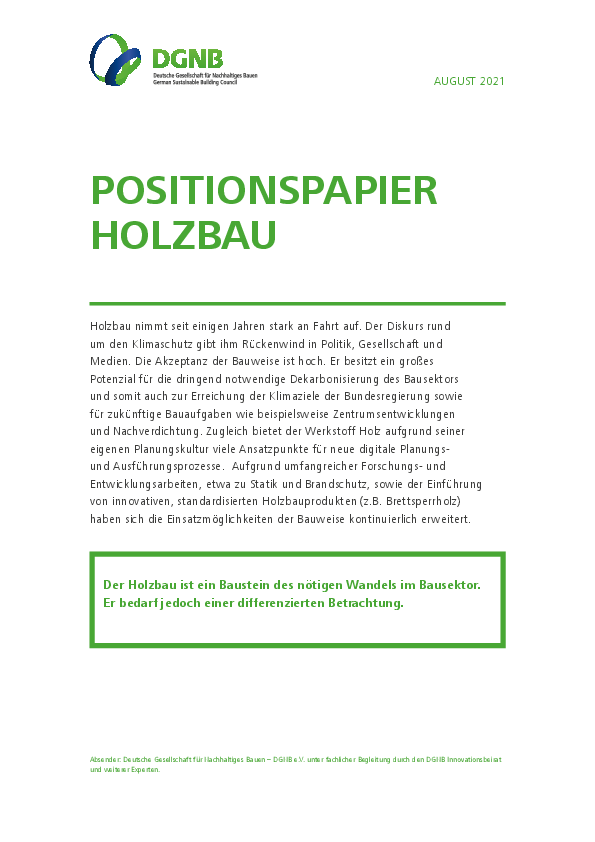
August, 2021 | Wood construction requires a differentiated approach
Wood construction has been on the rise for a number of years now. The climate protection debate is giving it a boost in politics, society and the media. Acceptance of this construction method is high. It has great potential for the urgent decarbonisation of the construction sector and thus for achieving the German government's climate targets, as well as for future construction tasks such as town centre development and urban densification. At the same time, wood as a material offers a wide range of starting points for new digital planning and execution processes due to its own specific planning culture. Extensive research and development in areas such as structural design and fire protection, as well as the introduction of innovative, standardised wood construction products (e.g. cross-laminated timber), have led to a steady expansion in the range of applications for this construction method.
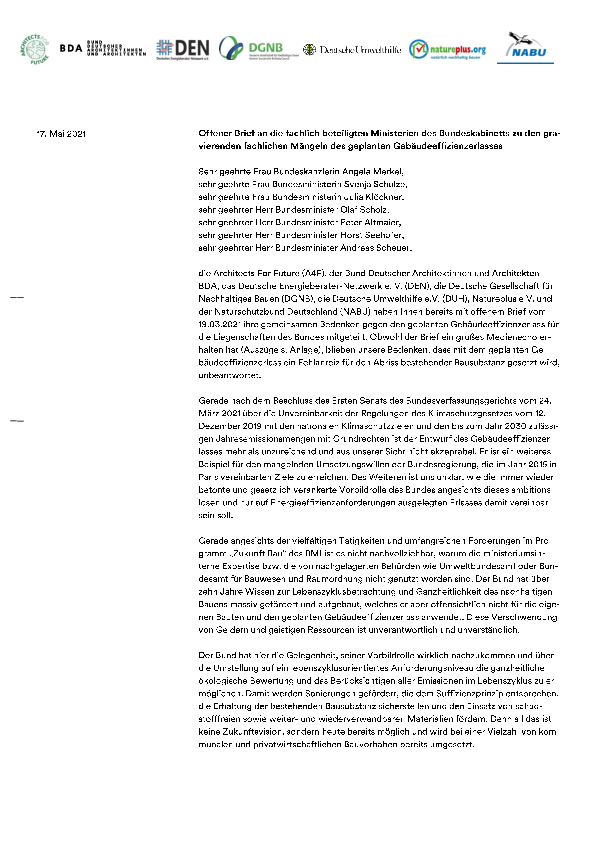
May, 2021 | Open Letter on the Building Efficiency Decree
The DGNB and five other organisations have sent a joint letter to various federal cabinet ministries criticising the planned decree on building efficiency for government property. It is a commitment to climate protection and resource efficiency.
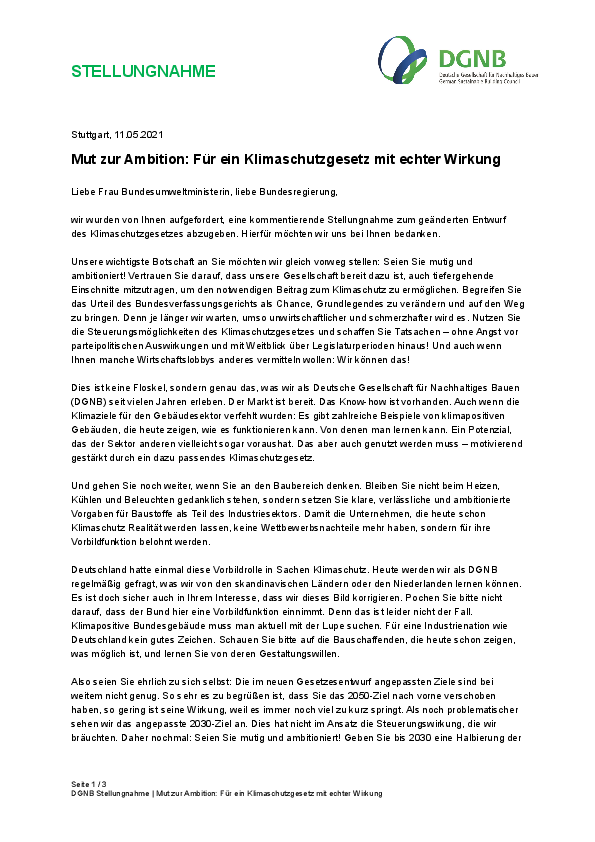
May, 2021 | The courage to be ambitious: For a climate change law that will have a real impact
The German government is obliged to improve its climate protection law following a ruling by the Federal Constitutional Court on 29 April 2021. A new draft has now been presented. The DGNB commented on behalf of the Federal Ministry for the Environment, Nature Conservation and Nuclear Safety (BMU).
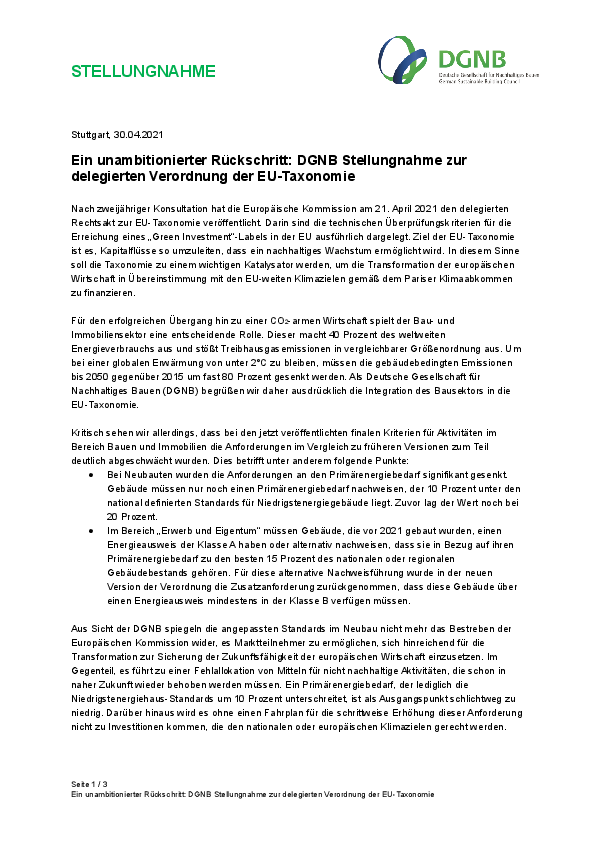
April, 2021 | An unambitious step backwards: DGNB statement on the delegated regulation of the EU Taxonomy
After two years of consultation, the European Commission published the delegated act on the EU taxonomy on 21 April 2021. It details the technical verification criteria for obtaining a "green investment" label in the EU. The construction and real estate industries are key to the successful transition to a carbon-neutral economy. This is why the DGNB explicitly welcomes the inclusion of the building industry in the European Taxonomy. As DGNB, we therefore strongly welcome the integration of the construction sector into the EU Taxonomy. However, we are critical of the fact that the final criteria for activities in the construction and real estate sector, which have now been published, have in some cases significantly weakened the requirements compared to earlier versions.
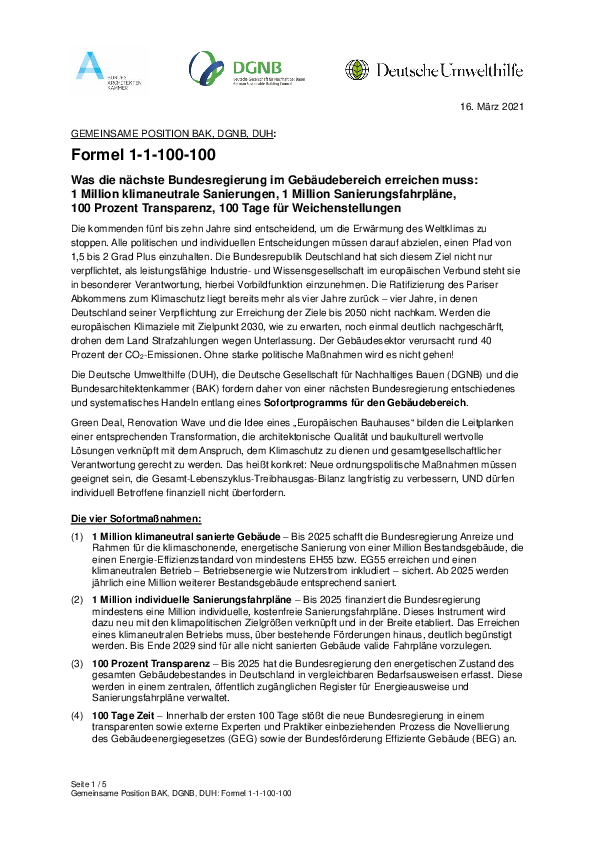
March, 2021 | Common statement BAK, DGNB, DUH: Formula 1-1-100-100
What the next federal government must achieve in the building sector: 1 million climate-neutral renovations, 1 million renovation plans, 100 per cent transparency, 100 days to set the course.
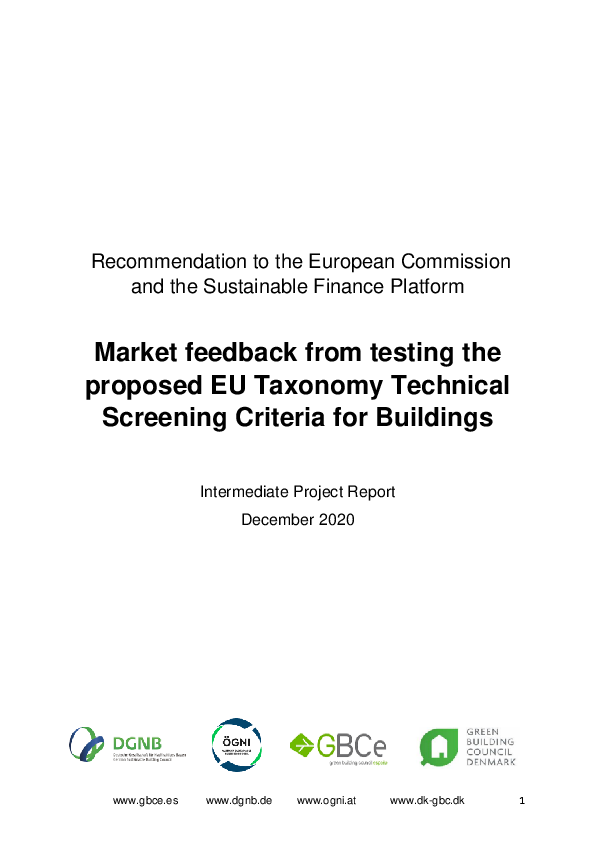
December, 2020 | Recommendation to the European Commission and the Sustainable Finance Platform
The DGNB has conducted a market study with three other European GBCs on the application of the proposed taxonomy criteria to real buildings. Based on this application, the partners made recommendations to the European Commission and the Sustainable Finance Platform for the adaptation of the proposed criteria. The recommendations have been communicated to the European Commission and the Sustainable Finance Platform as part of the official call for feedback / consultation in December 2020.
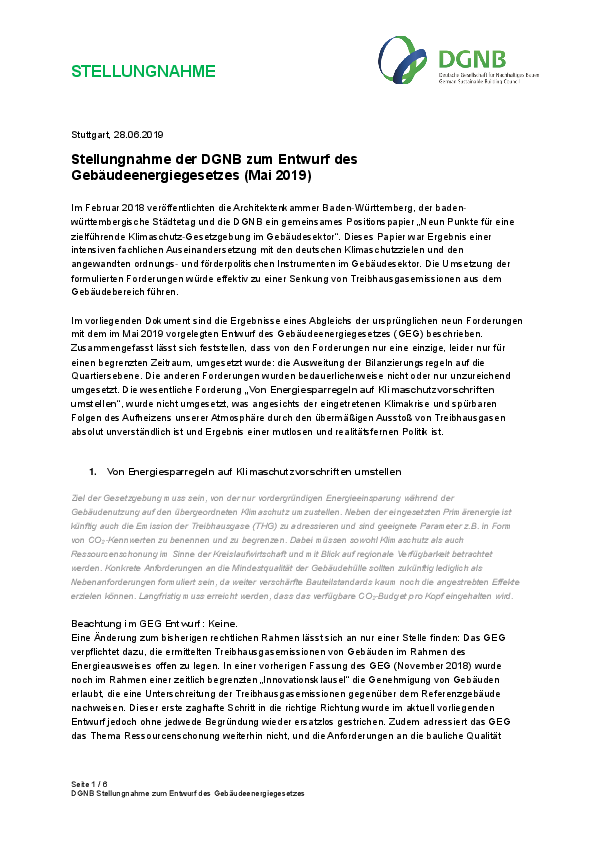
June, 2020 | DGNB statement on the drafting of the building energy law
The DGNB addresses the German government and the responsible federal ministers in a comprehensive statement on the planned Building Energy Act. In this statement, the DGNB describes why it welcomes the objectives behind the draft law, but is disappointed with its implementation. Neither has the application of the law been noticeably simplified, nor does the law provide important and ambitious impulses and incentives for building in a climate-friendly and truly sustainable manner.
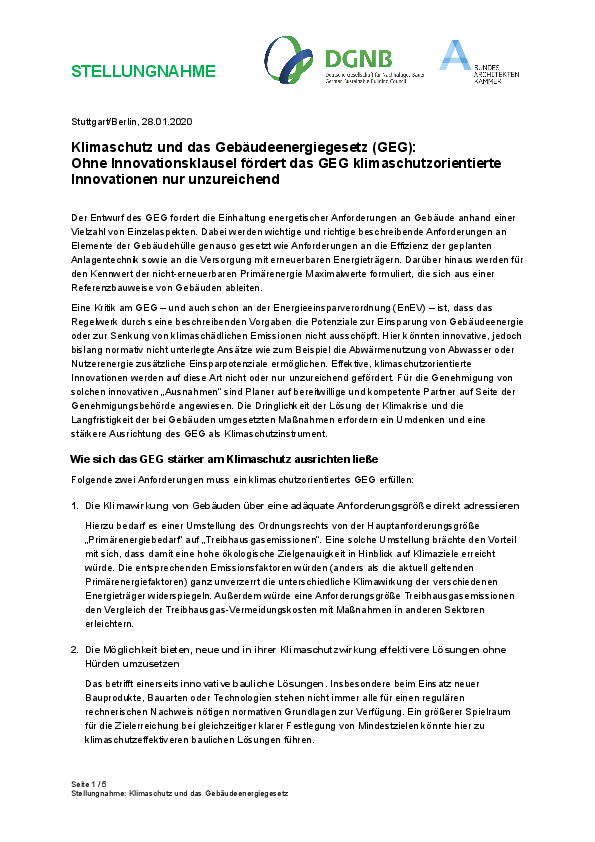
January, 2020 | Climate protection and the Energy Act for Buildings (GEG): Without an innovation clause, the GEG does not sufficiently promote climate-friendly innovations.
In a joint statement, the DGNB and the German Chamber of Architects (BDA) take a position on the current draft of the GEG (as of November 2019) and explain how the regulations could be more closely aligned with climate protection. They also argue why the innovation clause (§103) is necessary with regard to climate protection and cite relevant facts to address concerns.
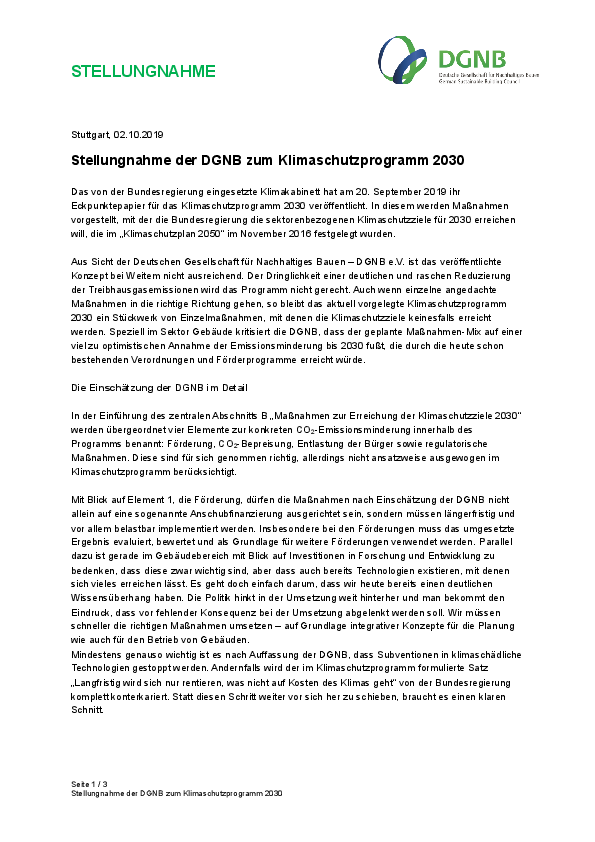
October, 2019 | Statement of the DGNB on the Climate Protection Programme 2030
From the DGNB's point of view, the published concept is far from sufficient. The urgency of a significant and rapid reduction in greenhouse gas emissions is not reflected in the programme. The Climate Protection Programme 2030 as currently presented remains a patchwork of individual measures that will by no means achieve the climate protection goals, even if some of the proposed measures are a step in the right direction. In the building sector in particular, the DGNB criticises the fact that the planned mix of measures is based on a far too optimistic assumption regarding the emissions reductions to be achieved by 2030, which would result from the regulations and subsidy programmes already existing.
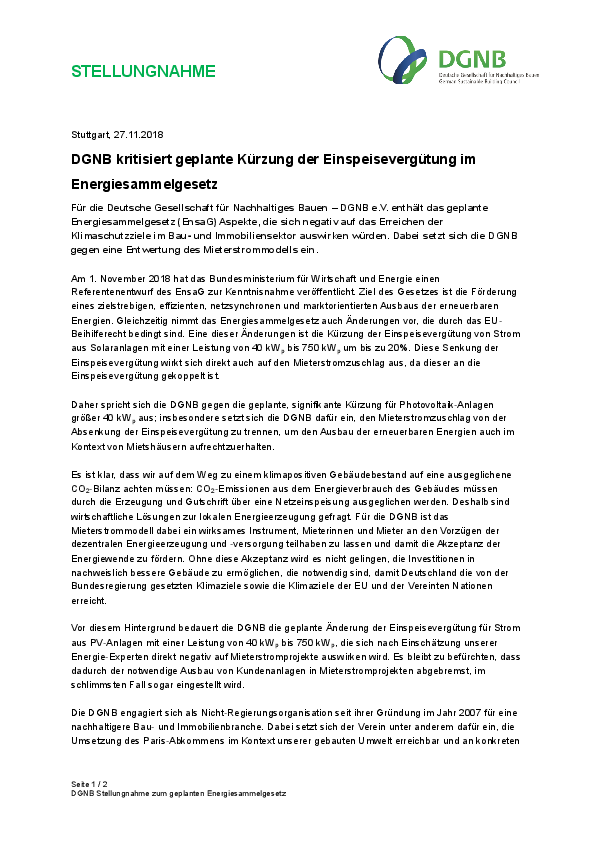
November, 2018 | DGNB criticises planned cuts to feed-in tariffs
In the DGNB's view, the planned German Energy Saving Act (EnsaG) contains aspects that would have a negative impact on achieving climate protection targets in the construction and property sector. In this context, the DGNB opposes a devaluation of the tenant electricity model.
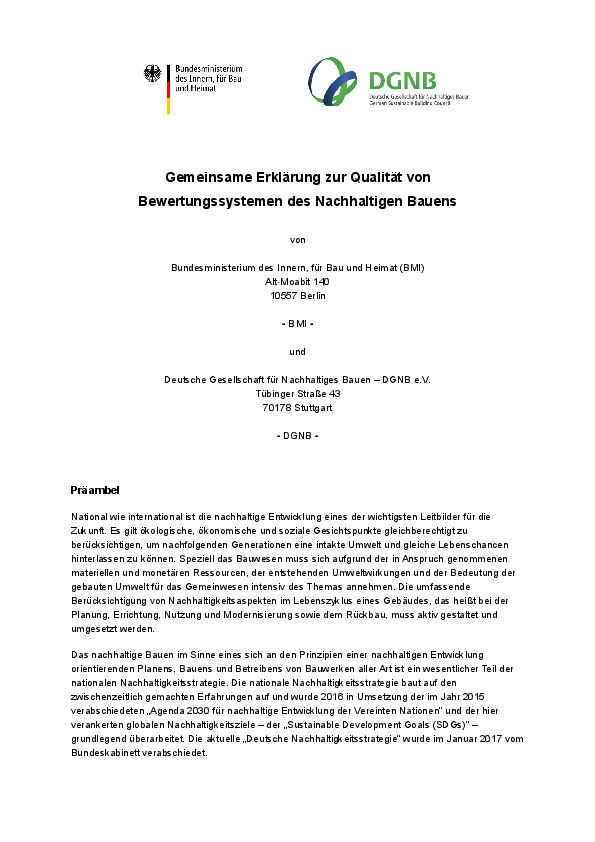
October, 2018 | Common Statement on the Quality of Sustainable Building Rating Systems
The DGNB and the Federal Ministry of the Interior have drawn up a common declaration on the quality of sustainable building rating systems. The declaration was signed on 9 October at EXPO Real in Munich by DGNB President Prof. Alexander Rudolphi and Gunther Adler, State Secretary in the Federal Ministry of the Interior for Construction and the Interior. Both institutions want to promote a holistic and life-cycle-oriented planning and construction practice that makes an active contribution to climate and resource protection with the principles of a German methodology for sustainability assessment formulated in the declaration. The document also defines the future cooperation between DGNB and BMI.
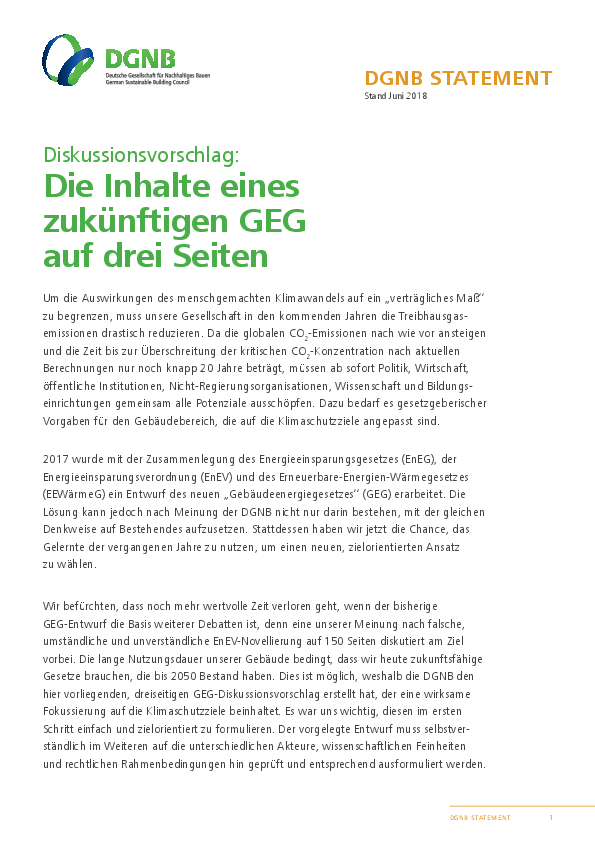
June, 2018 | DGNB Discussion Paper GEG 2050
In order to limit the effects of human-induced climate change to a "tolerable level", our society will have to drastically reduce greenhouse gas emissions in the coming years. Global CO2 emissions continue to rise and, according to current calculations, we have less than 20 years before the critical CO2 concentration is exceeded. Politicians, business, public institutions, non-governmental organisations, the scientific community and educational institutions must now work together to exploit all potential. This requires legislation for the building sector that is in line with climate protection goals.
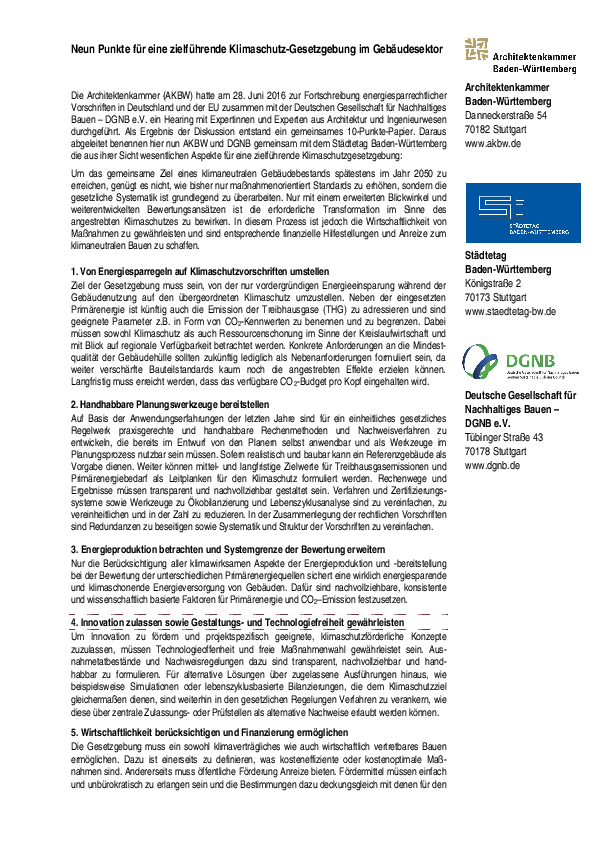
February, 2018 | Common position of the Chamber of Architects of Baden-Württemberg, the Association of Towns and Cities of Baden-Württemberg and the DGNB
The future government must reconsider climate protection. AKBW, DGNB and German Association of Cities call for nine points for targeted legislation in the construction industry.
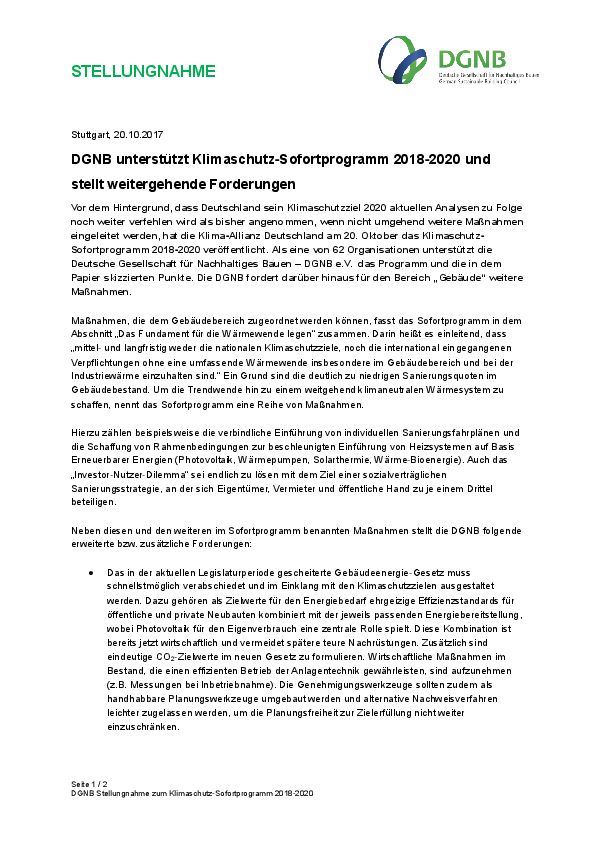
October, 2017 | DGNB statement on the revision of the EPBD
On 20 October, the German Climate Alliance published its Emergency Climate Protection Programme 2018-2020 against the backdrop that, according to current analyses, Germany will miss its 2020 climate protection target even further than previously assumed if no further measures are taken immediately. The DGNB is one of 62 organisations in support of the programme and the points in the paper. DGNB also calls for further measures in the building sector.
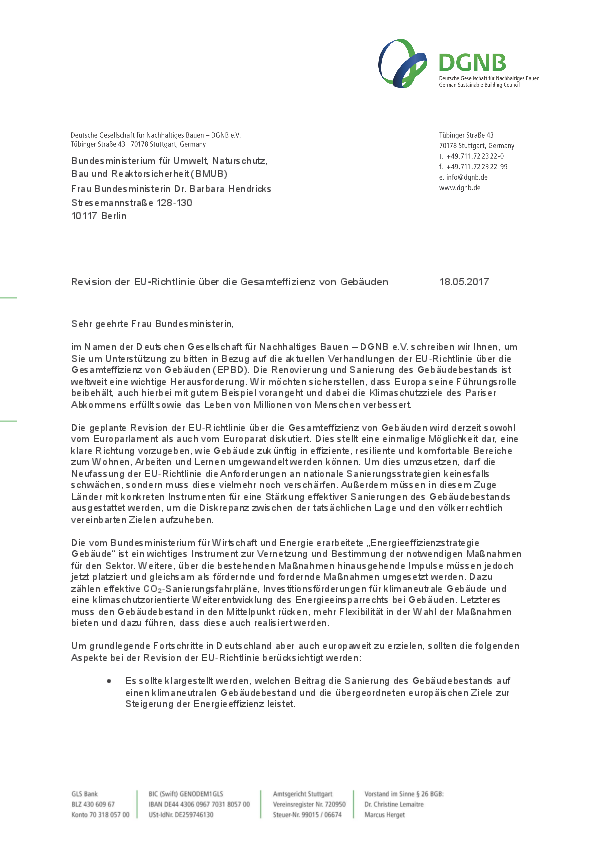
May, 2017 | Statement of the DGNB on the revision of the EPBD
The DGNB has taken a position on the EU Directive on the Overall Performance of Buildings (EPBD) during negotiations between the Council of Europe and the European Parliament. In a letter to various political representatives, the DGNB sets out its demands for the revision. These emphasise the importance of renovation strategies for existing buildings.
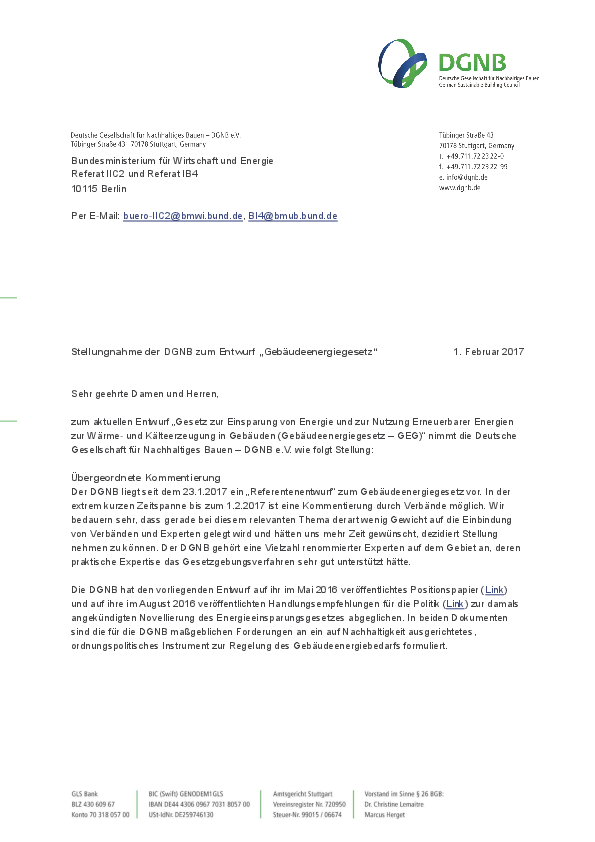
February, 2017 | DGNB statement on the draft "Building Energy Law"
The DGNB has issued a comprehensive statement on the current draft of the "Act on Energy Conservation and the Use of Renewable Energies to Heat and Cool Buildings (Building Energy Act - GEG)".
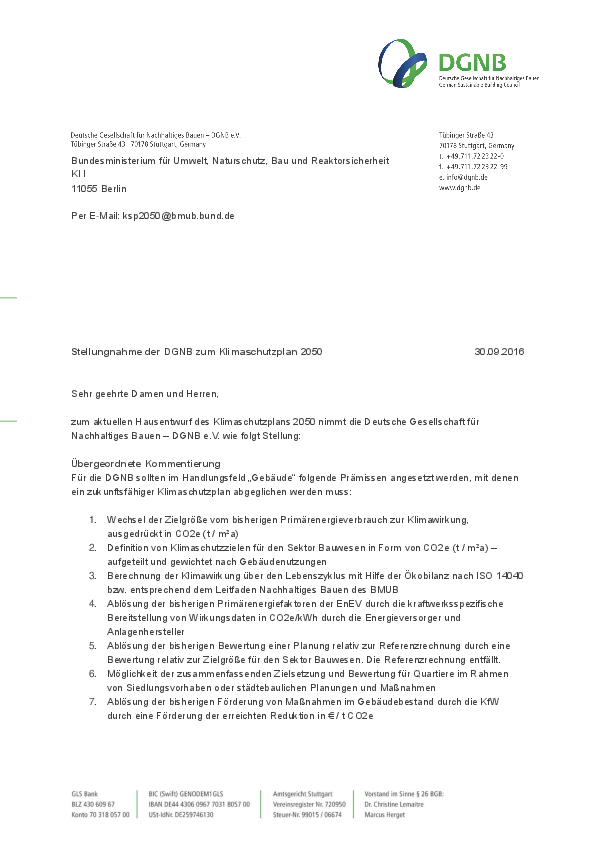
September, 2016 | Statement of the DGNB on the Climate Protection Plan 2050 (German)
The Climate Protection Plan 2050 is intended to bring together the national recommendations and measures for achieving the global climate protection goals. The DGNB has commented on the German government's draft of September 2016 and submitted a comprehensive statement.
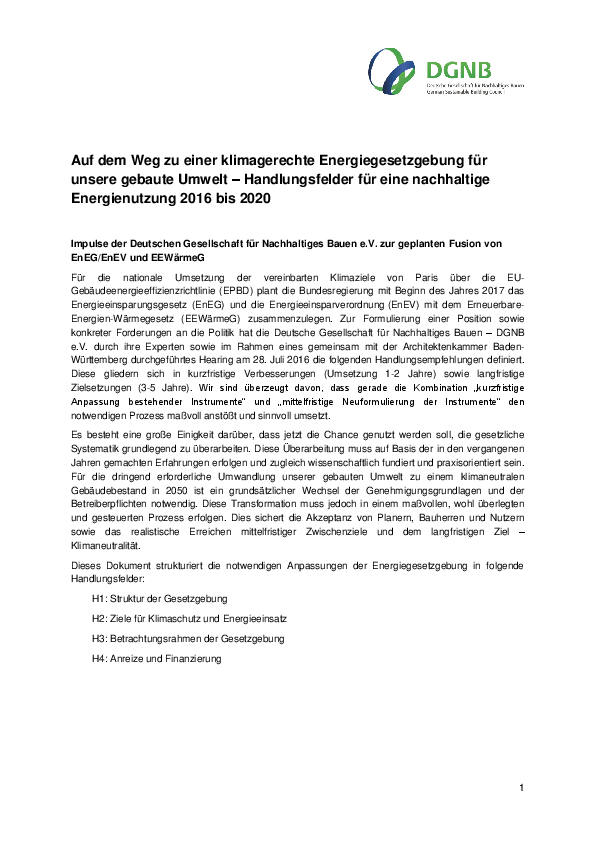
August, 2016 | Acting to achieve sustainable energy 2016-2020
On the way to a climate-friendly energy law for our built environment - Impulses from the DGNB on the planned merger of the EnEG/EnEV and the EEWärmeG (Renewable Energies Heat Act)
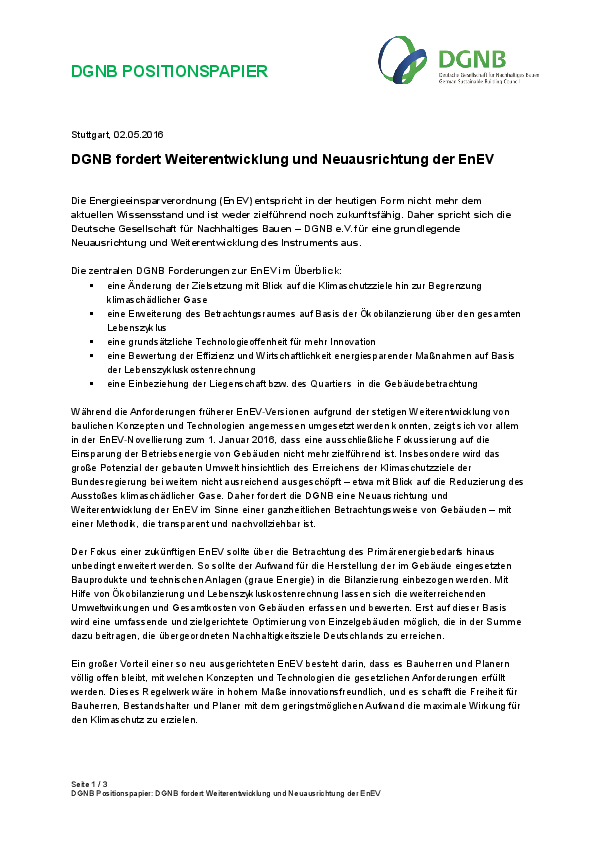
May, 2016 | DGNB position paper and background information on the EnEV
The German Energy Saving Ordinance (EnEV) in its current form is no longer in line with the current state of knowledge and is neither goal-oriented nor sustainable. For this reason, the German Sustainable Building Council (DGNB) is calling for a fundamental reorientation and further development of the instrument.
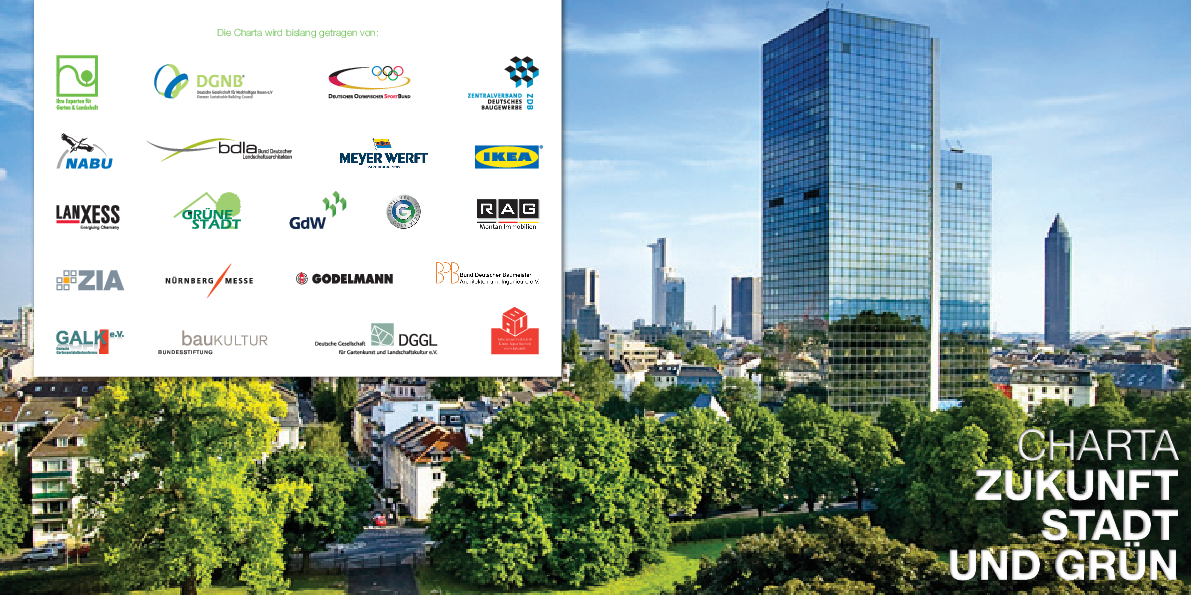
January, 2014 | Urban development policy requirements: Charter for the Future City and Green Spaces
"Green urban development in Germany - time to act instead of just talk! - This was the motto of the press conference organised by the Future City and Green Initiative on 21 January 2014 in Berlin. The initiators, the Bundesverband Garten-, Landschafts- und Sportplatzbau e.V. and the Stiftung DIE GRÜNE STADT, together with more than 20 companies - including the DGNB - signed up to key demands for urban development.
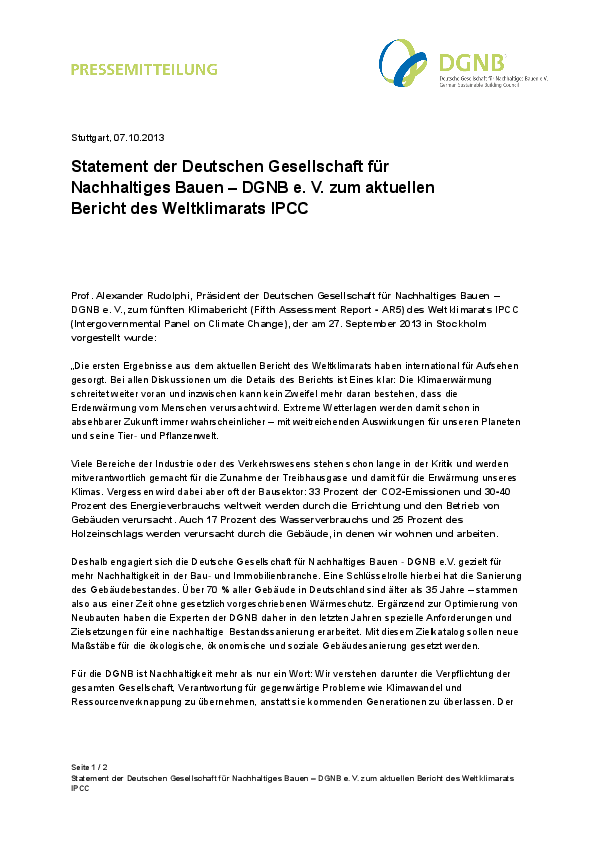
October, 2013 | DGNB statement on the report of the International Panel on Climate Change (IPCC)
DGNB President Prof. Alexander Rudolphi on the Fifth Assessment Report (AR5) of the Intergovernmental Panel on Climate Change (IPCC), presented in Stockholm on 27 September 2013.
Further publications and news
Your contacts
Felix Jansen
Director PR, Communications and Marketing
- Phone: +49-711-722322-32
- Email: F.JANSEN@DGNB.DE

